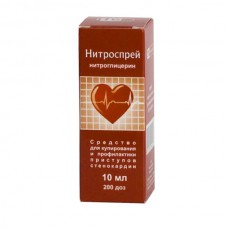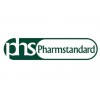Expiration date: 09/2026
The composition and form of issue:
Sublingual spray dosed, 1 dose contains active substance:
nitroglycerin 0.4 mg
(in the form of 1% alcohol solution)
excipients: ethyl rectified alcohol
in vials polypropylene, equipped with a mechanical dosing pumps, nozzles and protective caps, and 10 ml (200 doses) in the paper cartons 1 a bottle.
Description pharmaceutical form:
Clear, colorless liquid.
Pharmacokinetics:
Nitroglycerin upon sublingual application is rapidly and completely absorbed from the oral cavity into the systemic circulation. Bioavailability is 100% with sublingual intake, as excluded primary hepatic degradation of the drug. Cmax in plasma achieved within 4 min. the Relationship with blood plasma proteins is 60%. Rapidly metabolized with the participation nitratereductase with the formation of di - and mononitrates (only active isosorbide-5-Mononitrate), the ultimate metabolite is glycerol. Excreted by the kidneys as metabolites. Total clearance is 25-30 l/min. After taking the drug under the tongue T1/2 from blood plasma is 2.5 to 4.4 min. Circulating nitroglycerin strongly associated with erythrocytes and accumulates in the vessel walls. The main route of excretion of nitroglycerin extraction of metabolites in urine <1% of dose excreted unchanged.
Description pharmacological action:
Nitroglycerin is an organic nitrogen-containing compound with a primary venodilation action.
Effects of nitroglycerin due to its ability to release of its molecule nitric oxide, which is a natural endothelial relaxing factor. Nitric oxide increases the intracellular concentration of cyclic guanosinmonophosphat that prevents the penetration of calcium ions into smooth muscle cells and causes their relaxation. The relaxation of smooth muscles of the vascular wall and causes vasodilation, which reduces venous return to heart (preload) and the resistance of the systemic circulation (afterload). This reduces the work of heart and the need of myocardium in oxygen. Expansion of coronary vessels and improves coronary blood flow and contributes to its redistribution in the region with reduced blood circulation, which increases oxygen delivery to the myocardium.
The decrease in venous return leads to a decrease in filling pressure, improve blood supply of the upper subendocardialnah layers, reducing the pressure in the pulmonary circulation and regression of symptoms oteke light. Nitroglycerin exerts a Central inhibitory effect on sympathetic vascular tone, inhibiting the vascular component of pain syndrome. Nitroglycerin relaxes smooth muscle cells of the bronchi, urinary tract, gallbladder, bile ducts, esophagus, small intestine and colon. The action begins quickly, the effect is within 1-1,5 min and lasts approximately 30 min.
Indications:
- prevention of angina attacks by prophylactic use of the drug before physical activity
- relief of angina
- acute left ventricular failure (including acute myocardial infarction).
Contraindications:
- hypersensitivity to organic nitrates
- zakratougolnaya form of glaucoma
- severe hypotension
- increase of intracranial pressure caused by bleeding in the brain or trauma
- simultaneous reception of phosphodiesterase inhibitors
- age to 18 years of age (no sufficient clinical data).
Precautions: acute myocardial infarction with low filling pressure of the left ventricle (risk of decline in blood pressure and tachycardia, which may aggravate ischemia), congestive heart failure with low filling pressure of the left ventricle, severe anemia, thyrotoxicosis, hypertrophic cardiomyopathy (possible increased frequency of angina), severe renal insufficiency, hepatic insufficiency (risk of methemohlobinemia).
Application of pregnancy and breast-feeding:
No data on the penetration of the nitroglycerin into breast milk.
Application of pregnancy and during breast-feeding requires careful mapping of risks and benefits and should be under strict medical supervision.
Side effects:
From the CCC: dizziness, headache, tachycardia, fever, decrease in blood pressure rare (especially in overdose) — orthostatic collapse, cyanosis.
From the digestive system: dry mouth, rarely — nausea, vomiting, abdominal pain.
CNS: weakness rare anxiety, psychotic reactions, confusion, disorientation.
Allergic reactions: rarely — skin rash, itching.
Local reactions: hyperemia skin, burning under the tongue.
Other: rarely — blurred vision, hypothermia, methemoglobinemia.
Drug interactions:
Other vasodilators and archipartition drugs (&beta-adrenergic blockers, blockers slow calcium channels), ACE inhibitors, antipsychotics, tricyclic antidepressants, MAO inhibitors, procainamide and ethanol may enhance the hypotensive effect of nitroglycerin.
Nitroglycerin increases the effect of dihydroergotamine and reduces the efficiency of heparin. Against the background of quinidine and procainamide may occur orthostatic collapse.
Concomitant use with phosphodiesterase type 5 inhibitors (sildenafil, tadalafil, vardenafil) may increase the ability of the drug to blood pressure reduction.
Method of application and dose:
The drug should be taken on prescription to avoid complications.
Relief of angina attack. In the first attack of angina, apply 1 or 2 doses under the tongue. If necessary, you can reapply in 5-minute intervals. If after receiving three doses within 15 min of the attack is not blocked, you should immediately consult a doctor.
Prevention of angina attacks. 1 dose for 5-10 minutes prior to expected load or stress.
The highest single dose: 4 doses. The highest daily dose 16 doses.
The rules of the drug:
to sit
- remove the protective cap from the vial, hold the vial vertically
- open your mouth, hold for a few seconds breathing
- click once on the bottle, directing a stream of medication under the tongue
- close your mouth and try not to swallow the drug.
When first using or after long periods of non-use is recommended before direct application single dose to relieve in the air to fill the aerosol chamber.
Overdose:
Symptoms: headache, reducing AD, ortostatical gipotenzia, reflex tachycardia, dizziness, facial flushing, vomiting and diarrhoea, asthenia, hypersomnia, a feeling of heat. Extremely high doses (>20 mg/kg) cause of methemohlobinemia, cyanosis, dyspnoea and tachypnea, orthostatic collapse.
Treatment: in mild cases — the transfer of the patient in the supine position with raised legs in severe manifestations of overdose should be used General methods of treatment of intoxication and shock (including to fill the BCC, norepinephrine and/or dopamine).
The use of epinephrine (adrenaline) is contraindicated.
With the development of methemohlobinemia you can apply the following antidote and treatment:
- vitamin C — 1 g in the form of sodium salt or/
- methylene blue in/in the dose to 50 ml of a 1% solution
- toluidine blue/first dose of 2-4 mg/kg, then multiply by 2 mg/kg
- oxygen therapy, hemodialysis, transfusion (exchange) blood.
Precautions:
Nitroglycerin increases the excretion of catecholamines and vanillylmandelic acid in the urine.
The use of alcoholic beverages during the use of the drug is strictly prohibited.
Effects on ability to drive or to perform work requiring high speed physical and mental reactions. At the beginning of treatment should refrain from driving vehicles and activities potentially hazardous activities, require high concentration and psychomotor speed reactions. In the future, the degree of restriction is determined individually for each patient.
Storage conditions:
(away from fire).


